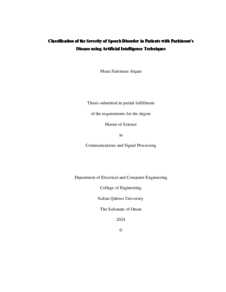وثيقة
Classification of the severity of speech disorder in patients with Parkinson’s disease using artificial intelligence techniques.
المصدر
Master's thesis
عناوين أخرى
تصنيف شدة اضطراب الكلام لدى المرضى بالباركنسون باستخدام تقنيات الذكاء الاصطناعي
الدولة
Oman
مكان النشر
Muscat
الناشر
Sultan Qaboos University
ميلادي
2024
اللغة
الأنجليزية
نوع الرسالة الجامعية
Master's thesis
الملخص الإنجليزي
Parkinson’s disease (PD) is a neurodegenerative disorder that affects movement, speech,
and other functions. Dysarthria is a speech disorder often associated with PD. It can reduce
intelligibility, making it difficult for people with PD to communicate. In recent years,
there has been a growing interest in the use of machine learning (ML) and artificial
intelligence (AI) to diagnose this disorder. This study proposes an automated system for
classifying the severity of dysarthria in patients with PD using a combination of speech
signal analysis, ML algorithms, and voting techniques. This study uses a variety of
features extracted from the speech signal, including statistical signal characterization
(SSC), Mel-frequency cepstral coefficients (MFCCs), and discrete packet wavelet
decomposition (DPWD). These features are used to train ML models, such as support
vector machines (SVM), k-nearest neighbors (KNN), neural networks (NN), and
convolutional neural networks (CNN). Two versions of the system were implemented:
one using the National Technical Institute of the Deaf (NTID) scale, which classifies the
severity of dysarthria into five levels, and a simpler version that classifies the severity into
three levels: mild, moderate, and severe. Several approaches were explored to improve
the test accuracy, including segmenting the subjects, and voting on different levels. The
results of this project can assess the treatment of speech disorders in patients with PD and
improve the success of the speech therapies. The results of the evaluation showed that the
system was able to classify the severity of dysarthria using DPWD and hard voting
between KNN, SVM, and NN with an accuracy of 90.5% using Segment-Subject-Model
voting on the data collected by the hospital of the university of Kiel, Germany.
الملخص العربي
مرض باركنسون هو اضطراب عصبي تنكسي يؤثر على الحركة والكلام والوظائف الاخرى. ُعسر التلفظ هو اضطراب في الكلام يرتبط عادة بداء باركنسون. يمكن أن يؤدي إلى انخفاض القدرة على الفهم، مما يجعل من الصعب على المصابين بداء باركنسون التواصل. في السنوات الاخيرة، كان هناك اهتمام متزايد باستخدام التعلم الالي (ML ( والذكاء الاصطناعي (AI (لتشخيص هذا الاضطراب. تقترح هذه الدراسة نظا ًما آليًا جديدًا لتصنيف شدة ُعسر التلفظ في مرضى باركنسون باستخدام مجموعة من تحليل إشارات الكلام وخوارزميات التعلم الالي وتقنيات التصويت. تستخدم الدراسة مجموعة متنوعة من الميزات المستخرجة من إشارة الكلام، بما في ذلك توصيف الاشارة الاحصائية (SSC (و معامالت (MFCCs (وتحليل حزم المويجات المتقطعة (DPWD (. يتم استخدام هذه الميزات لتدريب نموذج التعلم الالي، مثل الات الدعم المتجه (SVM (والجار الاقرب ك (KNN( والشبكات العصبية (NN (والشبكات العصبية الالتفافية (CNN (. تم تنفيذ نسختين من النظام: إحداهما تستخدم مقياس المعهد الوطني التقني للصم (NTID(، الذي يصنف شدة ُعس ُر التلفظ إلى خمسة مستويات، ونسخة أبسط تصنف الشدة إلى ثالثة مستويات: خفيف، معتدل، وشديد. تم استكشاف العديد من النهج لتحسين دقة الاختبار، بما في ذلك تقسيم تسجيل الفرد الى أجزاء والتصويت على مستويات مختلفة. يمكن لنتائج هذا المشروع تقييم عالج اضطراب الكلام لدى مرضى باركنسون وتحسين نجاح علاجات النطق. أظهرت نتائج التقييم أن النظام كان قاد ًرا على تصنيف شدة ُعس ُر التلفظ باستخدام DPWD والتصويت بين KNN و SVM و NN بدقة ٪90.5 باستخدام تصويت جزئي- كلي-ألي على البيانات المستحصلة من مستشفى جامعة كيل في ألمانيا.
قالب العنصر
الرسائل والأطروحات الجامعية

